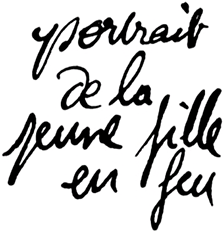 Portrait of a Lady on Fire
Portrait of a Lady on Fire Céline Sciamma, 2019
#10, 2019 Skandies
(Quick translation question for those whose French is better than mine: doesn’t “la jeune fille”, over on the left there, translate to “the young girl” rather than “a lady”? I mean, yes, the subject of the portrait is in her late twenties and thus well into adulthood, and for that matter is only two and a half months younger than the painter of the portrait in question… but it’s not like Céline Sciamma was unaware of this, nor of the existence of indefinite articles. She could have called her movie Portrait d’une dame en feu if she’d wanted to, but she didn’t. Why are the translators “correcting” her? Are they trying to bolt on a Henry James reference or something?)
I used to live a few blocks away from an arthouse theater; Ellie actually worked there for a time, but I never went in, because I swore off movie theaters long before I moved near this one. Portrait of a Lady on Fire was the movie on offer when the pandemic struck and put the world on pause, so the title stayed up on the marquee so long that it seemed like the movie played there forever. I was curious to finally see what it was about. It turns out that we’re in some unspecified era in the past—looks like the eighteenth century to me—on an island that initially seems to have a grand total of one house on it. It later turns out that there are some other residents kicking around, but for a big chunk of the running time it seems like we have a cast of four: mother, daughter, servant, visitor. The mother used to have two daughters, one off at a convent, the other arranged to be married to a gentleman from Milan. The betrothed daughter didn’t care for this arrangement and threw herself off a cliff. Now the other daughter has been brought back from the convent to marry the gentleman in her late sister’s place, but she isn’t thrilled about it either. Enter the visitor, the daughter of a famous painter who has begun to forge an artistic career of her own. The mother has brought her to the island on a secret mission: the gentleman wants to see a picture of the replacement fiancée before he’ll agree to marry her, but she refuses to pose for a portrait. So the painter is to act like a companion who’s been brought in to keep the daughter company and make sure she doesn’t commit suicide. In reality, she is to surreptitiously memorize the daughter’s face and paint her on the sly.
As a history buff I did like the idea of a narrative built around a problem that technology solved two centuries ago—i.e., that acquiring an image of a distant person required the services of a skilled artist. But while this movie didn’t quite fall into the “too slow, gave up” category, it was slow enough that getting through it was a pretty tough slog. I see that some reviewers have commended it for its measured pace, as it eventually turns into a romance, and they were thrilled to see love develop in a movie rather than having one or both leads hit with an instant thunderbolt. And, like… yes, half the running time does elapse between first meeting and first kiss, and it’s a slow-moving film… but that’s still only an hour. Pattern 41 suggests that if slowly developing love is what you intend to convey, a feature film is not the medium for you. Maybe try a sitcom.
That said, Portrait of a Lady on Fire did go to show that my patterns are patterns and not iron-clad rules about how I will react to things. I don’t think I’ve formally written this up as a numbered pattern, but long-time readers will recall me griping on many occasions about how much I hate the formulaic setup-callback screenwriting trick. For some reason the example that springs to mind at the moment is from the 1989 Batman movie, which has the Joker use a very long-winded catchphrase—“You ever dance with the devil in the pale moonlight?”—both in the present and in a flashback, and then has Batman throw it back at him. It could hardly be more ham-handed. This movie uses a similar device, twice—once involving a number, once a piece of music—and, for me, it worked really well, both times. I still can’t say I liked the movie, but the last five minutes elevated my opinion of it substantially, largely on the strength of these callbacks—I actually gasped at one of them. So who knows—maybe one day I’ll even like a movie with a dog in it or something.
 |
 |
 |
 |
||
|---|---|---|---|---|---|
Tumblr |
this site |
Calendar page |
|||